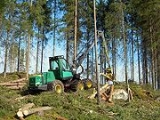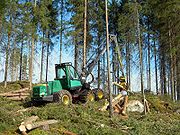
Cut-to-length logging
Encyclopedia
Cut-to-length logging
(CTL) is a mechanized harvesting system in which trees are delimbed and cut to length directly at the stump
. CTL is typically a two-man, two-machine operation with a harvester
felling, delimbing, and bucking trees and a forwarder
transporting the logs from the felling to a landing area close to a road accessible by truck
s.

 The capital cost
The capital cost
s for a typical CTL operation, with one harvester and one forwarder, are quite high. The price of the machines alone are approx. US$1,000,000.
CTL is the primary logging method in European countries, while full-tree logging and the even older technique of tree-length logging are more popular in North America
and less developed countries, where tree sizes can exceed the capacity of the harvester's felling head, i.e., tree stems with a butt diameter of over 70 centimeters. CTL lends itself to timber harvesting in plantation forestry
where stems are often harvested before they reach large dimensions.
Logging
Logging is the cutting, skidding, on-site processing, and loading of trees or logs onto trucks.In forestry, the term logging is sometimes used in a narrow sense concerning the logistics of moving wood from the stump to somewhere outside the forest, usually a sawmill or a lumber yard...
(CTL) is a mechanized harvesting system in which trees are delimbed and cut to length directly at the stump
Tree stump
After a tree has been cut and felled, the stump or tree stump is usually a small remaining portion of the trunk with the roots still in the ground. Stumps may show the age-defining rings of a tree. The study of these rings is known as dendrochronology....
. CTL is typically a two-man, two-machine operation with a harvester
Harvester (forestry)
A harvester is a type of heavy forestry vehicle employed in cut-to-length logging operations for felling, delimbing and bucking trees. A forest harvester is typically employed together with a forwarder that hauls the logs to a roadside landing.- History :...
felling, delimbing, and bucking trees and a forwarder
Forwarder
A forwarder is a forestry vehicle that carries felled logs from the stump to a roadside landing. Unlike a skidder, a forwarder carries logs clear of the ground, which can reduce soil impacts but tends to limit the size of the logs it can move...
transporting the logs from the felling to a landing area close to a road accessible by truck
Truck
A truck or lorry is a motor vehicle designed to transport cargo. Trucks vary greatly in size, power, and configuration, with the smallest being mechanically similar to an automobile...
s.


Capital cost
Capital costs are costs incurred on the purchase of land, buildings, construction and equipment to be used in the production of goods or the rendering of services, in other words, the total cost needed to bring a project to a commercially operable status. However, capital costs are not limited to...
s for a typical CTL operation, with one harvester and one forwarder, are quite high. The price of the machines alone are approx. US$1,000,000.
CTL is the primary logging method in European countries, while full-tree logging and the even older technique of tree-length logging are more popular in North America
North America
North America is a continent wholly within the Northern Hemisphere and almost wholly within the Western Hemisphere. It is also considered a northern subcontinent of the Americas...
and less developed countries, where tree sizes can exceed the capacity of the harvester's felling head, i.e., tree stems with a butt diameter of over 70 centimeters. CTL lends itself to timber harvesting in plantation forestry
Plantation
A plantation is a long artificially established forest, farm or estate, where crops are grown for sale, often in distant markets rather than for local on-site consumption...
where stems are often harvested before they reach large dimensions.
Advantages compared to full-tree logging
- Cleaner wood since the logs are not skiddedSkidderA skidder is any type of heavy vehicle used in a logging operation for pulling cut trees out of a forest in a process called "skidding", in which the logs are transported from the cutting site to a landing. Here they are loaded onto trucks , and sent to the mill...
on the ground to the landing.(in tree length more than full tree) - More fresh wood.(in tree length more than full tree)
- Less damage to retained trees in thinningThinningThinning is a term used in agricultural sciences to mean the removal of some plants, or parts of plants, to make room for the growth of others.- Forestry :...
operations - Typically requires fewer types of machines in an operation
- No need to clear large landings close to the road
- Greater personnel safety due to enclosed/protected machine cabs
- More environmentally friendly due to:
- less soilSoilSoil is a natural body consisting of layers of mineral constituents of variable thicknesses, which differ from the parent materials in their morphological, physical, chemical, and mineralogical characteristics...
disturbance than in skidding operations (if improper skidding practices take place) - no slashSlash (logging)Slash, or slashings, is a forestry term that refers to coarse and fine woody debris generated during logging operations or through wind, snow or other natural forest disturbances. Slash generated during logging operations may increase fire hazard and some North American states have passed laws...
dumped at the landing - higher retention of foliar nutrients within the harvested area
- less soil
Disadvantages compared to full-tree logging
- Somewhat higher capital cost per volumeVolumeVolume is the quantity of three-dimensional space enclosed by some closed boundary, for example, the space that a substance or shape occupies or contains....
when used in large scale clear cuts - Use of higher technology requires more operator know-how and training
- More down time due to a lot of moving parts (especially on the harvester)

